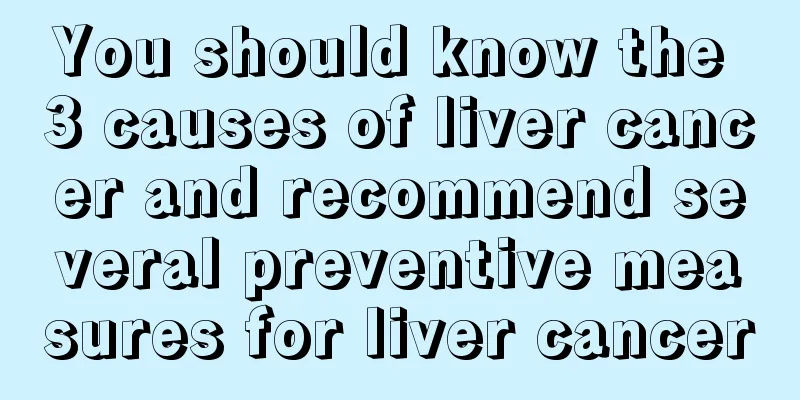You should know the 3 causes of liver cancer and recommend several preventive measures for liver cancer

|
The two main causes of liver cancer and their preventive measures are as follows: (1) Hepatitis B virus (HBV) 90% of liver cancer cases in my country have been infected with HBV, and the chronic hepatitis B infection rate among liver cancer patients is 10 to 20 times higher than that of the control group. The stronger the HBV index, the higher the risk of liver cancer. Chronic hepatitis B is related to cirrhosis. 80% (60 to 90%) of liver cancer occurs on the basis of cirrhosis, most of which is post-hepatitis cirrhosis. Precautions: Vertical transmission from mother to child and hepatitis B infection between 0 and 5 years old may be the main reasons for the permanent existence of hepatitis B virus carrier status. Therefore, in high-incidence areas and cities with conditions, newborns and susceptible people should be vaccinated with hepatitis B vaccine. The involvement of multiple hepatitis viruses and virus variants should also be considered, and it is not appropriate to rely on one measure alone. In recent years, it has been reported that hepatitis C virus (HCV) is related to 100% of liver cancer incidence, and the prevention of hepatitis C will become a practical problem in the future; in addition, attention should be paid to the transmission routes of hepatitis B and C, such as blood transfusion, injection, acupuncture, and shaving. People receiving dialysis, hemophiliacs, spouses of HBsAg carriers, medical workers, and especially those who come into contact with blood and blood products are also high-risk groups. (2) Aflatoxin Aflatoxin B1 (AFB1) is a strong chemical carcinogen for the liver and may be an initiator or promoter of liver cancer in humans. It has a synergistic carcinogenic effect with HBV. 10% of the residents in the high-incidence area of Qidong ingest aflatoxin (derived from corn and peanuts in warm and humid areas), which is 10 to 100 times higher than that of Beijing residents. Precautions: Prevent food from getting moldy, strictly manage hygiene, and prevent ingestion of AFB. Remove or wash moldy food, reduce the intake of corn and peanuts in high-incidence areas, and encourage drinking green tea to prevent AFB from inducing liver cancer. (3) The relationship between drinking water pollution and liver cancer deserves attention There are many organic carcinogens and cancer promoters in lakes, ponds and ditches, as well as a type of blue-green algae that is easy to grow. Its toxic effect on the liver has been identified as another risk factor for liver cancer. In-depth research may reveal the mystery of drinking water and liver cancer. Precautions: Improve water quality and pay attention to drinking water hygiene, especially in areas with high incidence and serious industrial pollution. Rural areas should drink running water and well water, and cities should use less polluted water sources as tap water. |
Recommend
Measures to prevent lymphoma
Lymphoma is a disease that is easy to spread. Whe...
Cervical bloodletting therapy has these harmful effects!
Cervical spondylosis is a common bone disease for...
What are the diagnosis and treatment methods for irritable bowel syndrome
Many people in today’s society do not pay attenti...
The difference between four-dimensional and cardiac color Doppler ultrasound
Giving birth to a new life is a sacred and solemn...
What diseases can be easily caused by watching TV for a long time
With the development of science and technology, m...
What should I do if I feel stomach discomfort after drinking too much tea?
In life, many people may have had this experience...
Which department should I go to for depression
Depression is a psychological disorder that is re...
Pain in the joint where the thigh meets the hip bone
Pain in the joint where the thigh meets the hip b...
What to eat when your heart beats too fast? It turns out it’s these four types of food
A fast heartbeat is a symptom that many people ex...
Causes, symptoms and hazards of chronic nasopharyngitis
In life, many people suffer from chronic nasophar...
The functions and effects of ox horn bracelets
We all know that ox horns have high medicinal val...
What are the methods for examining oral mucosa
Nowadays, more and more people are affected and t...
Symptoms of arm stretch
Maybe you feel that the pain in your body is beca...
Dressing in the beginning of autumn should follow the principle of keeping warm in spring and keeping cool in autumn
It is advisable to dress in a way that “covers in...
What shampoo oil should I use to make my hair smooth and shiny
In daily life, everyone has to wash their hair, b...









